阿尔茨海默病,美国在研项目简述(2024)
2024-09-01 Hanson临床科研 Hanson临床科研 发表于上海
我们仅对美国国立卫生研究院(NIH)年资助的在研AD项目进行梳理,希望给同仁们的选题思路提供一点启发。
阿尔茨海默病(AD)是最常见的中枢神经系统变性病,也是美国人群中第六位的主要死因;主要表现为记忆力减退、认知功能障碍和行为变化。
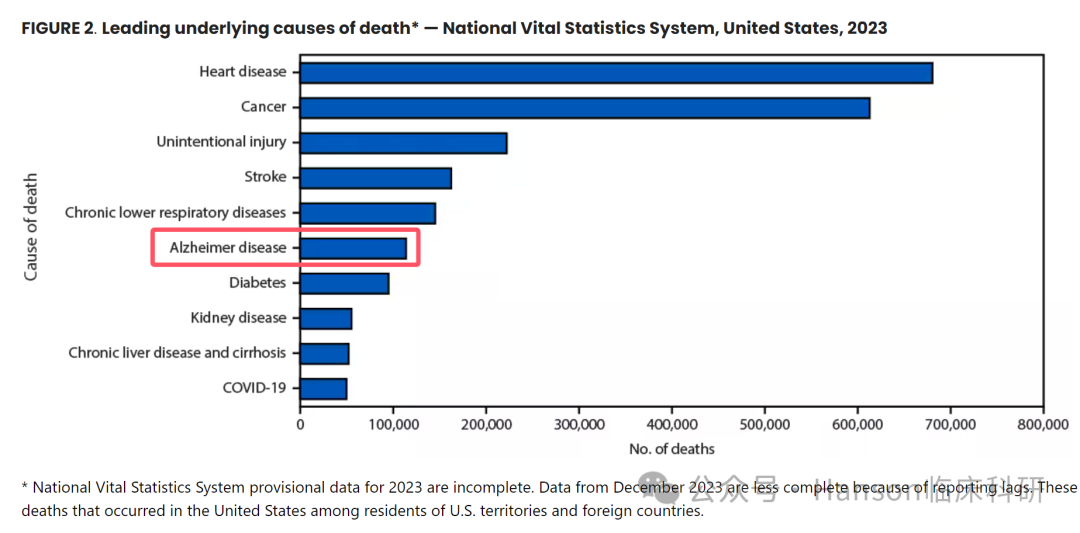
AD的治疗近年来取得了一些进展,主要集中在针对淀粉样蛋白和Tau蛋白的靶向治疗。新药如Lecanemab和Donanemab等抗体类药物通过清除脑中的淀粉样蛋白沉积,已在临床试验中显示出改善认知功能的潜力。
但AD的临床诊疗仍面临着许多尚未解决的临床问题,包括:
1)早期诊断困难:尽管有一些生物标志物和成像技术,但早期诊断仍不够准确,常常无法在无症状或轻度症状阶段发现疾病。
2)病因和病理机制不完全清楚:阿尔茨海默病的具体发病机制仍未完全明了,尤其是淀粉样蛋白和Tau蛋白如何相互作用并推动疾病进展。
3)有效治疗方案缺乏:目前的治疗主要是减缓症状,没有真正阻止或逆转疾病进程的药物,大多数临床试验也未能成功。
4)个体化治疗挑战:阿尔茨海默病患者的病情进展和反应各不相同,难以实现个体化精准治疗。
5)预防策略有限:尽管生活方式干预被认为有潜在的预防作用,但缺乏明确的指导策略和证据支持哪些措施最为有效。
这些问题的存在使得阿尔茨海默病的管理和研究仍然是全球医学界的重要挑战。
我们仅对美国国立卫生研究院(NIH)年资助的在研AD项目进行梳理,希望给同仁们的选题思路提供一点启发。
2024年,以“Alzheimer”为检索词、在题目中进行检索,美国NIH针对AD的在研有147项。
一,谁获得了这些研究?
1,在研AD课题最多的PI
目前在研AD基金最多的PI主要包括:
-
Case Western Reserve University的Haines, Jonathan L. ;
-
University of Miami Miller School of Medicine的Pericak-Vance, Margaret A.;
-
University of Pittsburg的Handen, Benjamin L;
-
University of Alabama at Birmingham的Roberson, Erik D.;
-
Icahn School of Medicine at Mount Sinai的Roussos, Panos ;
-
Tulane University of Louisiana的Bazzano, Lydia;
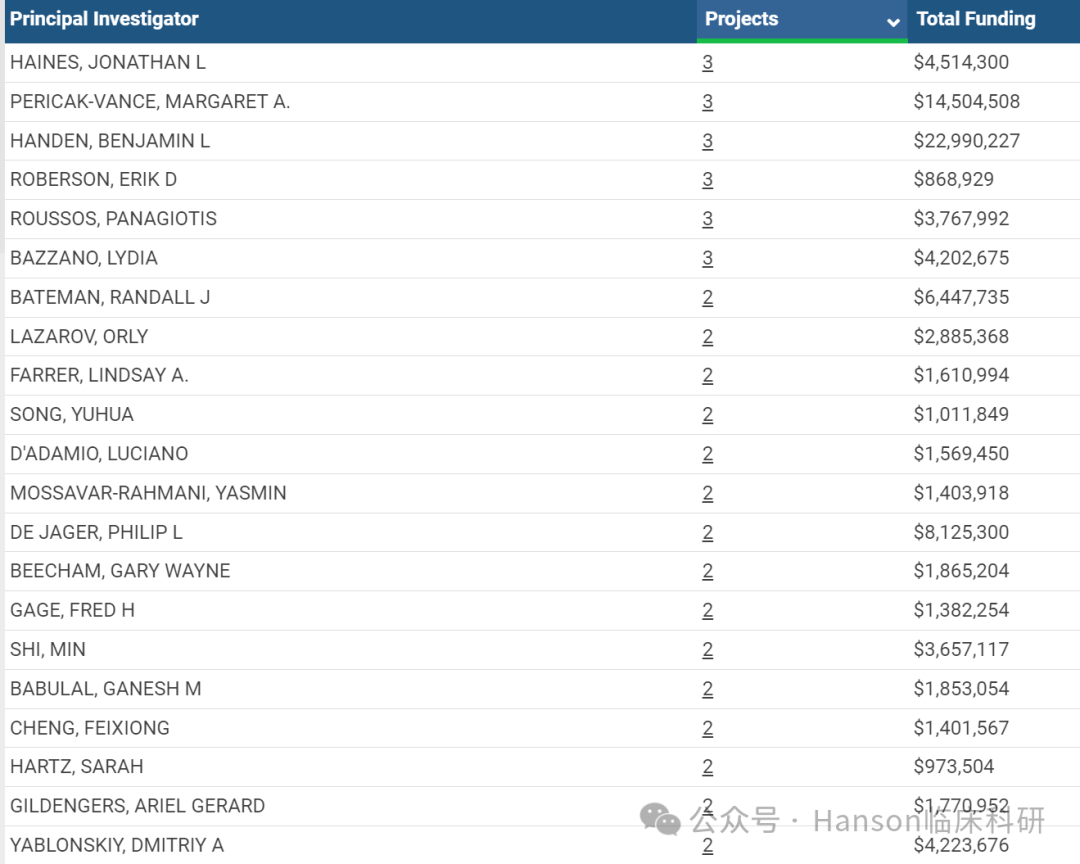
2,AD课题最多的研究机构
目前在研AD基金最多的大学主要包括:
-
圣路易斯华盛顿大学、
-
迈阿密大学医学院、
-
阿拉巴马大学伯明翰分校、
-
哥伦比亚大学健康科学系、
-
加州大学欧文分校等。

二,AD研究热点是什么?
AD研究领域总览(根据关键词)

A,认知障碍的研究项目最多
有42项在研基金涉及到了认知障碍,关注最多的方面包括风险因素、ADRD、临床试验、疗效、临床前期等临床研究。
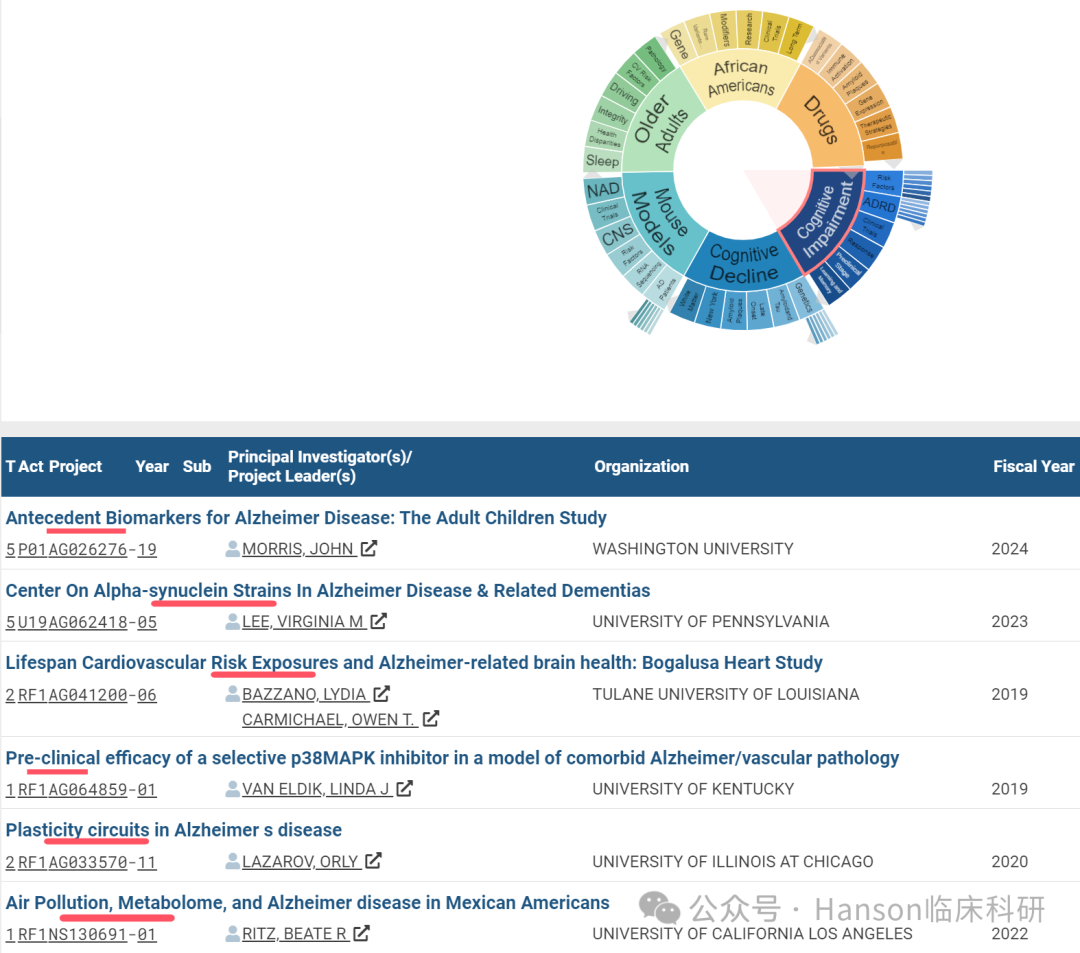
B,认知减退的研究
同样有33项研究涉及到认知减退,研究领域主要涉及遗传基因、Tau、晚发型、Aβ斑块、白质等机制研究。
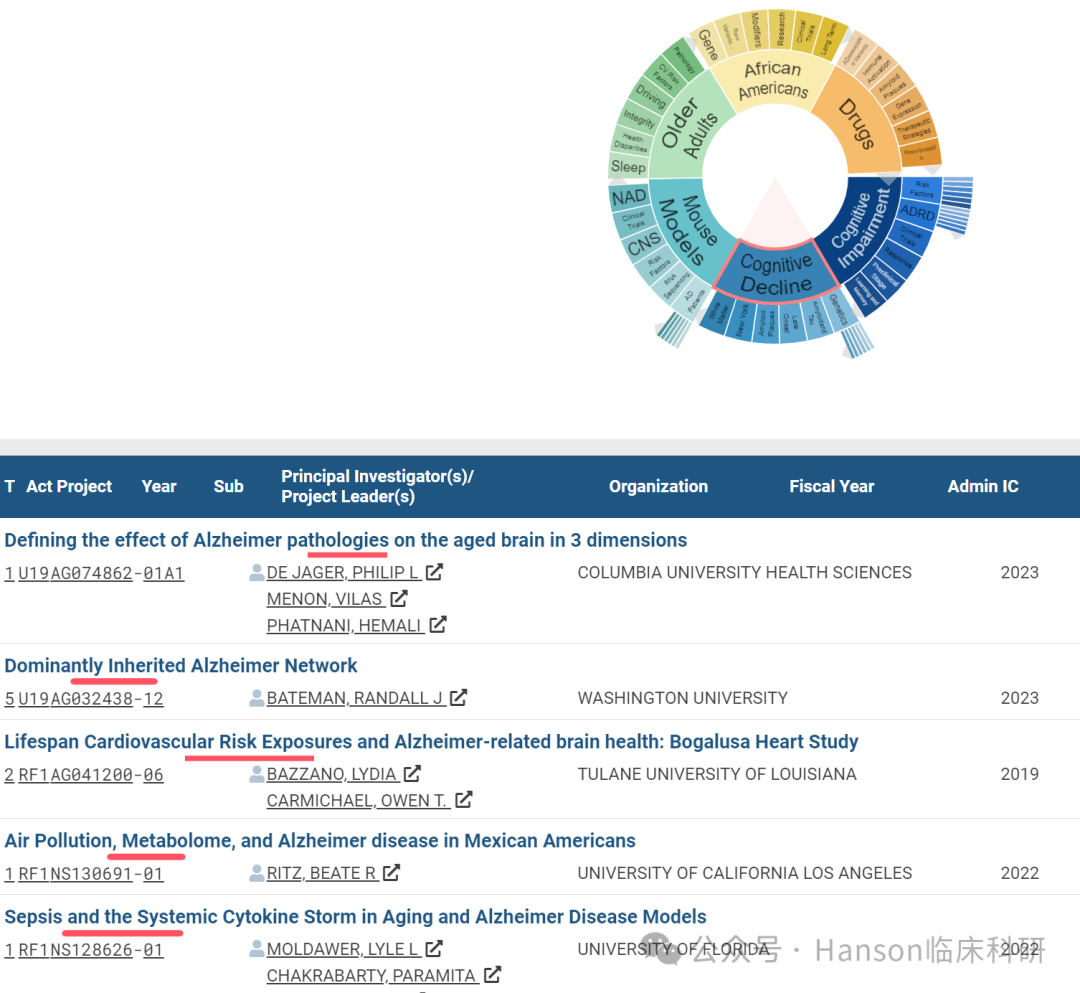
C,动物模型
有29项研究涉及到AD的动物模型研究,涉及的关键词包括如AD患者、RNA筛检、风险因素、CNS、NAD等。
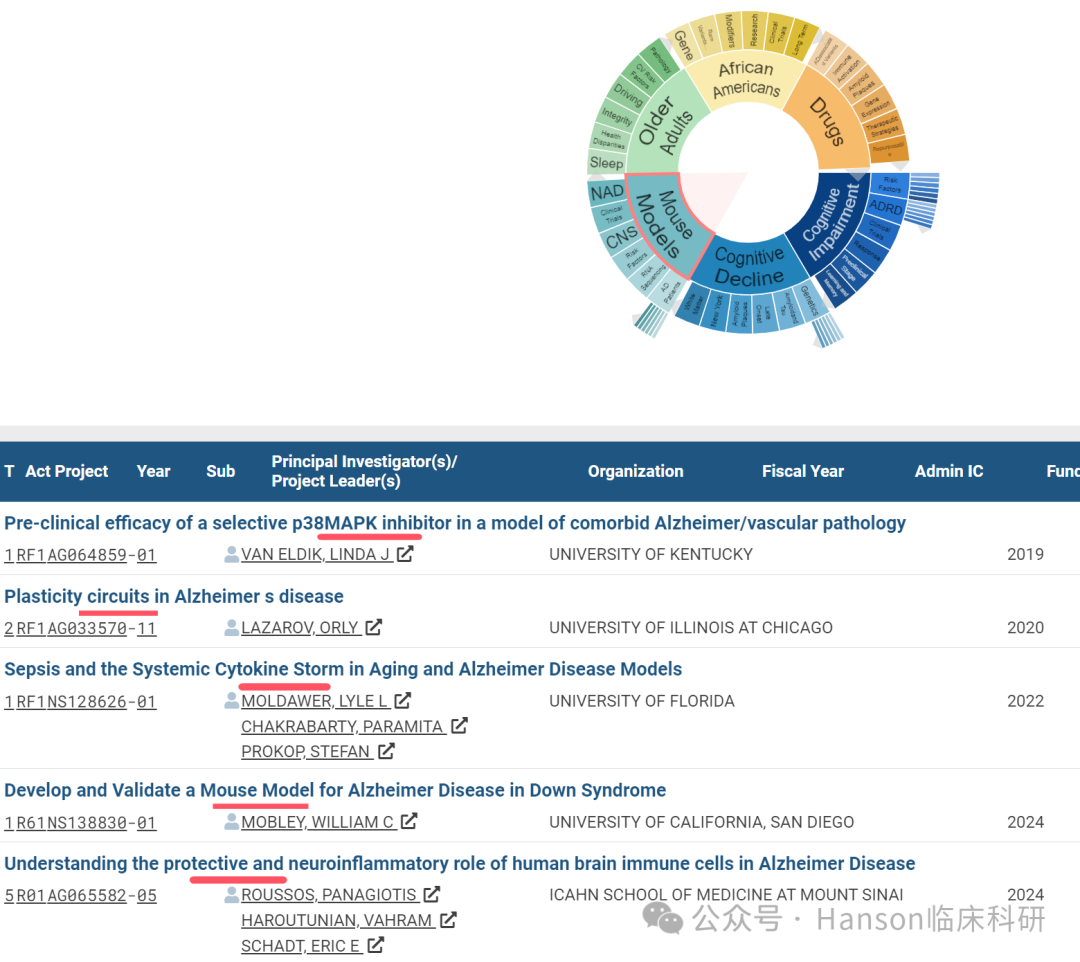
其他AD研究大的方向也包括老年AD患者的特征、新药研发等。
三,借鉴与突破
我们也分享在AD领域的几项课题摘要,希望对同仁们有所启发。
A,Understanding the protective and neuroinflammatory role of human brain immune cells in Alzheimer Disease
Despite extensive clinical and genomic studies, the mechanisms of development and progression of Alzheimer's disease (AD) remain elusive. Microglia and other myeloid origin cells (collectively called human brain immune cells, or HBICs) have recently emerged as crucial players in the pathogenesis of AD.
The proposed work addresses some of the limitations of previous research and is focused on: (1) cell type specific and single cell studies in immune cells isolated from human brain tissue; and (2) a systematic study of the regulatory effects of non-coding DNA on gene and protein expression, which is necessary given that the majority of common risk variants are situated in non-coding regions of the genome.
More specifically, our application is uniquely designed to: (1) apply innovative genomic approaches and generate multi-omics data from HBICs isolated from 300 donors, including whole genome sequencing, RNAseq, ATACseq, HiC chromosome conformation capture and proteomics; (2) perform state-of-the-art single cell analysis that will allow us to assess the diversity of HBIC subpopulations, as well as detect those that are associated with AD; (3) connect AD risk loci with changes in the regulatory mechanisms of gene and protein expression in HBICs; and (4) organize HBIC multiscale data in functional networks and identify key drivers for AD.
Our overall hypothesis is that HBIC subpopulations assume a neuroprotective role during aging and early stages of AD, but as disease progresses, specific HBIC subpopulations transform to neuroinflammatory phenotype(s). This conversion is partially driven by AD risk genetic variants, which affect regulatory mechanisms of genes that are key drivers of neuroinflammatory HBIC subpopulations.
Successful completion of the proposed studies will provide: (1) an increased mechanistic understanding of dysfunction in AD risk loci; (2) prioritization of significant loci and genes for future mechanistic studies; and (3) access to large-scale, multidimensional datasets, together with systems level analyses of these datasets for transcriptional regulation in HBICs, which is an urgently needed (and currently missing) resource.
B, Alzheimer variants: Propagation of shared functional changes across cellular networks
Genetic studies of Alzheimer’s disease (AD) and related-diseases (ADRD) have identified over 72 loci associated with susceptibility.
We systematically interrogate combinations of variants across validated AD loci in a cell autonomous and non-autonomous manner using a combination of molecular, epigenetic, and functional assays.
As part of this effort, we propose to establish a novel AD Locus Annotator interface that synthesizes information about AD-associated sequence features from reference databases encompassing existing multi-omic and clinical data, as well as new data sets that capture quantitative proteoform and cellular functional data; these latter two data modalities have been under-characterized in AD research to date, but are crucial to identifying cross-loci interactions.
From this synthesized data analysis and portal effort, we then establish a set of gene editing efforts to validate and extend our mechanistic understanding of multi- locus functional networks from these AD-associated sequence features.
Taken together, these analyses and experiments allow us to link the heterogeneity of AD-associated genetic variation and clinical manifestations into a coherent framework that link AD loci with the temporal sequence of events in AD onset and progression.
本网站所有内容来源注明为“梅斯医学”或“MedSci原创”的文字、图片和音视频资料,版权均属于梅斯医学所有。非经授权,任何媒体、网站或个人不得转载,授权转载时须注明来源为“梅斯医学”。其它来源的文章系转载文章,或“梅斯号”自媒体发布的文章,仅系出于传递更多信息之目的,本站仅负责审核内容合规,其内容不代表本站立场,本站不负责内容的准确性和版权。如果存在侵权、或不希望被转载的媒体或个人可与我们联系,我们将立即进行删除处理。
在此留言


















#AD# #阿尔茨海默病#
19
是前沿吗?
16
前沿吗?
16